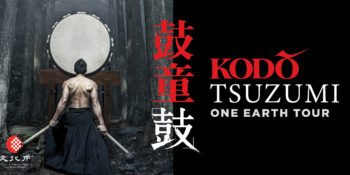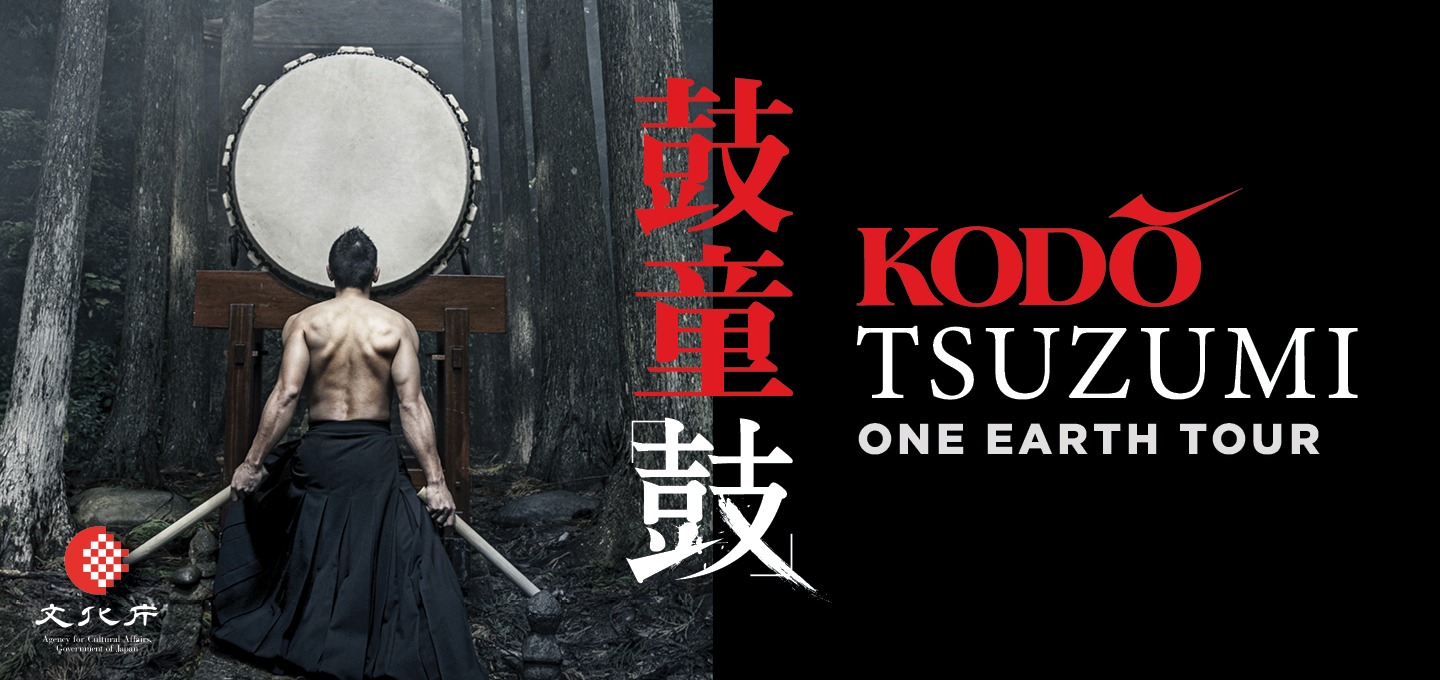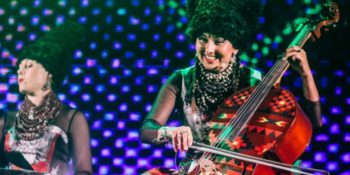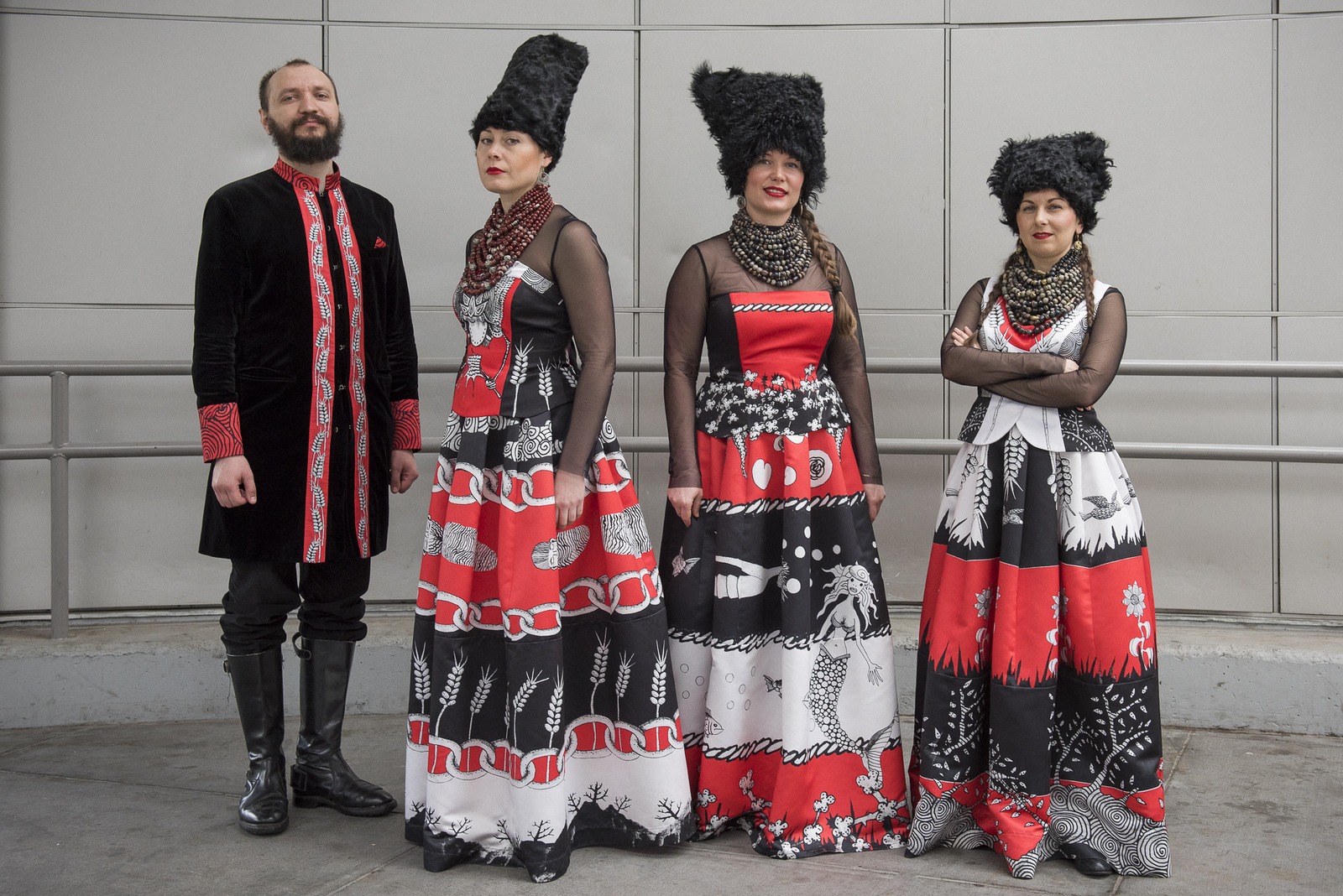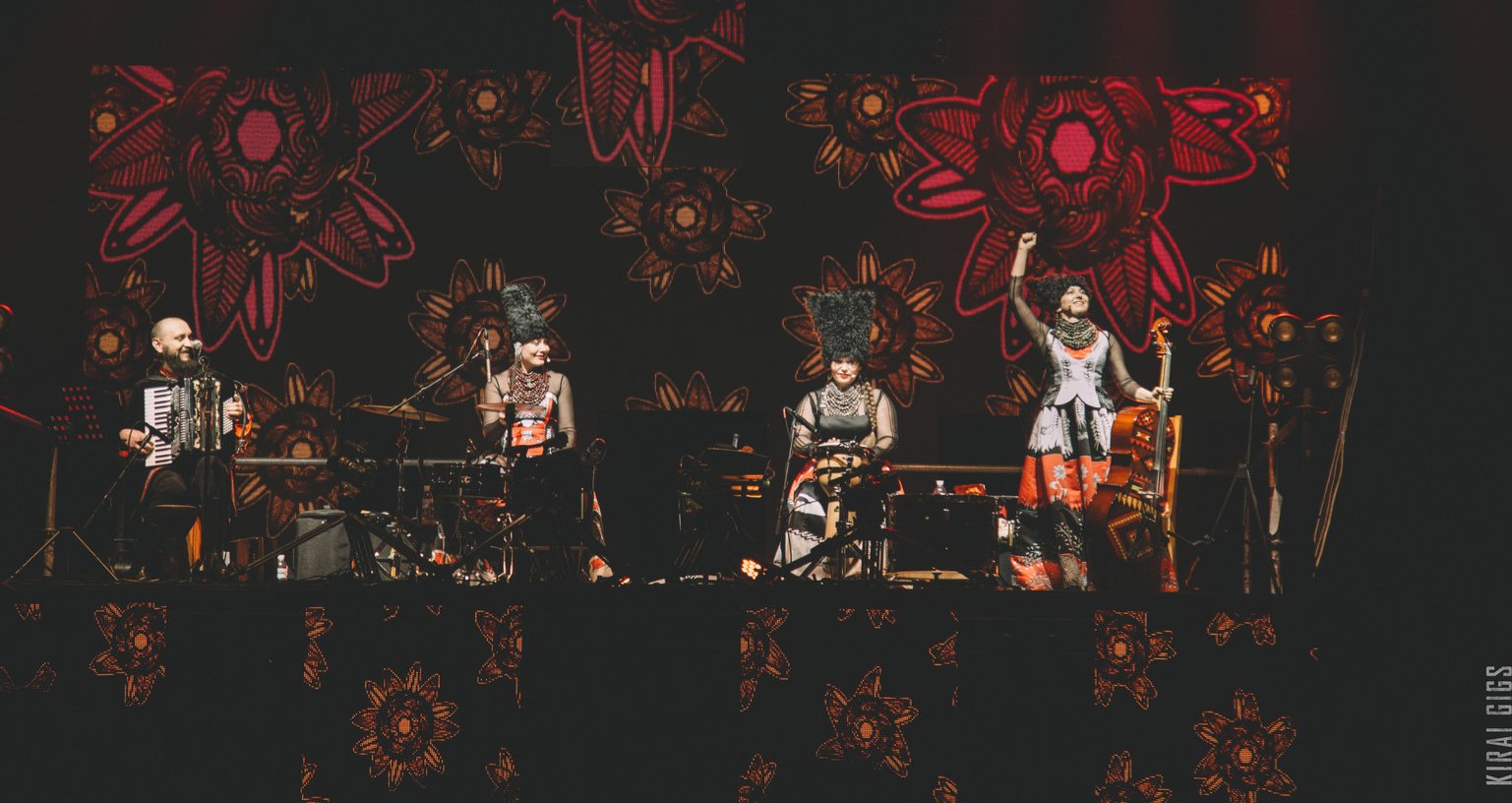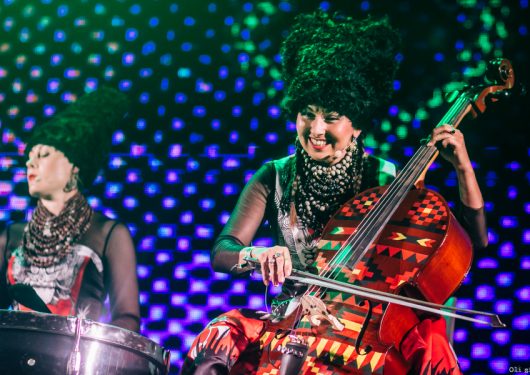A Chamber Music Series Concert Presented by Members of the Nashville Symphony
Modern Masterpieces for Brass

Select members of the Nashville Symphony presented ‘Modern Masterpieces for Brass’ at Schermerhorn Symphony Center on Wednesday, March 8, 6:00 p.m. This free event was offered as part of the Chamber Music Series and featured the following Nashville Symphony musicians:
Alec Blazek, trumpet
William Leathers, trumpet
Patrick Walle, horn
Paul Jenkins, trombone
Gilbert Long, tuba
Audience members were asked to sit in the center orchestra section nearest the stage as space allowed. On stage were chairs, stands, and percussion equipment that remained from an earlier rehearsal; however, the front part of the stage was lowered and cleared, except for a closed quintet seating schematic. A lighting plot brought additional focus to what would become the performance area.
Phillip Ducreay, Education and Community Engagement Program Manager, opened the concert by welcoming attendees and previewing upcoming performances by the Nashville Symphony. Even though it is understood that the Chamber Music Series falls within Ducreay’s purview, this commercial for future subscriptions and ticket sales seemed to somewhat distract from the music about to be offered – perhaps that was the price of admission to this free performance.
Of this series, the Nashville Symphony suggests the following on the organization’s website:
The Nashville Symphony Chamber Music Series provides an informal and interactive concert-going experience. With programming developed by members of the orchestra, this FREE evening of music and conversation is a wonderful way to get to your Nashville Symphony musicians and explore the history and artistry behind the music.
The intent behind such a series is commended and very much appreciated. I am not convinced that the aim of this series is being fully realized, or that such an ambitious endeavor is possible within a sixty-minute timetable. What made this concert informal – a slightly earlier downbeat, musicians wearing all black instead of concert black, general seating? A handful of audience members asking questions of the musicians didn’t seem like much of a conversation, although the audience was learning a few personal facts about the musicians during this portion of the event. Surely there is more that could be done if an objective is to actually, “. . . get to [our] Nashville Symphony musicians.” The ensemble entered from backstage, performed, and left, never once breaking the proscenium.
While the format and its execution of this performance may leave questions, the artistry did not. Works written by five living composers were featured:
Jennifer Higdon
Fanfare Quintet (2002)
David Sampson
Morning Music (1982)
Caleb Hudson
White Rose Energy (2016)
Kenneth Amis
Bell Tone’s Ring (1999)
Eric Ewazen
Colchester Fantasy (1987)
The program offered a broad emotional landscape and hinted at the awesome power of the medium to serve as a mirror for societal, political, and religious victories and shortcomings alike. This narrative of awareness was introduced on the printed program, too, with the following acknowledgement:
We acknowledge that Greater Nashville was originally home to the Yuchi people, the Shawnee people, and the Eastern Cherokee people, who lived on this land for thousands of years and countless generations before they were forcibly moved by colonization and the government. We would like to emphasize that despite this history, there are still members of these communities that live in Nashville today. The legacy of the enslaved individuals who helped build the city and the neighborhood we know today is also not forgotten. We recognize their strength and resilience through colonialism, white supremacy, and detrimental policies. To directly make an impact, we recommend that you donate to the Native American Indian Association of Tennessee at naiatn.org/donate.
This acknowledgement took up a quarter of the printed program, but it was never directly referenced. It is undecided whether this strengthens the gesture or offers the position, however rightly justified, similarly to an act of performative governance.
Of the works performed, David Sampson’s Morning Music left quite an imprint. Trumpeter Alec Blazek was the first member of the ensemble to address the audience and introduce a piece on the program – perhaps fitting as it was later acknowledged that the success of the concert owned much to Blazek’s administrative acumen of behalf of the group. Sampson writes the following about his piece:
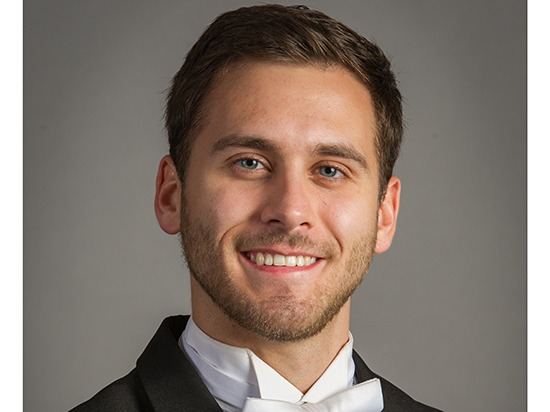
Morning Music for brass quintet was written during the summer of 1986 for the American Brass Quintet. It is a sequel to a previous work of mine titled In Memoriam: W.E.S. for woodwind quintet written in 1981 and premiered by the Dorian Wind Quintet. The subject of that piece was the murder of my brother, William Evan Sampson, by the Ku Klux Klan and American Nazis in 1979. Morning Music deals with my thoughts and feelings seven years later. As you will hear, the anguish over the death is as intense as ever, but strength and hope will gradually emerge from the despair. The work is one movement with clearly delineated sections ending with a fast-paced coda. I have dedicated Morning Music to my mother, Betty Sampson, whose optimism and resiliency have been an inspiration to me.
Each section of the work was expertly navigated by the ensemble. Hocketed intricacies throughout showcased impressive musicianship. The work opens with complex intervallic sequences written, at first, for solo tuba, that proved to be tamed by Gilbert Long. William Leathers, who played Trumpet 2 for this selection, aligned magically with trombonist Paul Jenkins in moments of repose. Leathers’ driving articulated pulsations in contrasting sections confronted the unimageable horrors through which the composer must have been attempting to deal with the unnecessary loss of his brother.
The contributions of Patrick Walle must not be overlooked. The horn was asked at times to battle a pair of trumpets, to extend the range of the trombone, and to make epic declarations as horns have been accustomed to do, among other feats, all within only just this one piece. There were moments when Walle’s placement within the seating schematic appeared to swallow his contributions more than was desired. I would be curious to hear another performance of Morning Music with Walle’s bell directed more towards the audience.
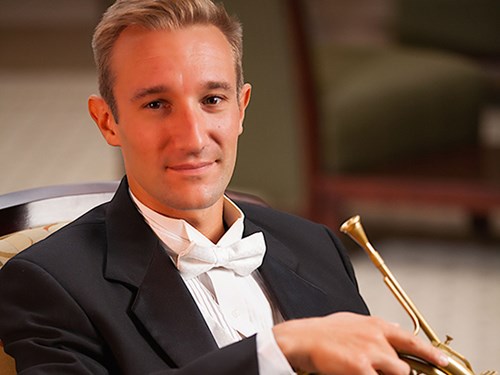
The composite of such an ensemble presumably should be greater than its parts. That proved true for this ensemble, but Alec Blazek’s trumpet playing needs recognized for being equally intoxicating and transporting. Blazek’s clear tone, nuanced articulation, and musicality can camouflage itself when serving in a supportive role, as well as lead style when charged to do so by the score. A perfect example of this dichotomy of role was highlighted by an ostinato figure that began a new section of David Sampson’s Morning Music. Blazek introduced the figure with authority before providing space in the sonic landscape for other voices within the ensemble to continue to develop the work’s texture.
Before the accelerating coda, which brings Morning Music to its conclusion, one musician had technical difficulties with their foot pedal; this pedal is used in tandem with an electronic tablet to advance one’s in place in a piece instead of using physical copies of music. I don’t reference this moment to embarrass the group, but rather to praise their professionalism and seemingly calm demeanor. Whether it was a malfunction or a Bluetooth connectivity issue, the music took a slightly extended pause, after which a discreet gesture was given by the affected musician to proceed to the next group entrance. Without fail all five musicians resumed and finished with a continued conviction.
Many successes could be cited from the other four pieces on the program and the surprise encore. For an ensemble that operates in an ad hoc capacity, it might be expected for there to be a lack of flexibility or cohesion, but this performance suggests quite the opposite. The approach to playing was similarly appreciated. The audience wasn’t met with five orchestral jocks playing at chamber music. The offerings were elevated and paced. I hope that Nashville realizes how fortunate it is to host a music organization of this caliber. Better yet, I hope that Nashville will support this musical organization and show that it is both appreciative and deserving of its artistry.
The Nashville Repertoiry in Polk Theater
August Wilson’s Fences
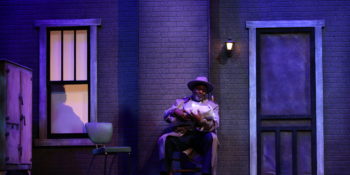
I was unfamiliar with this play before seeing the Nashville Repertory Theatre perform it on opening night in TPAC’s Polk Theater, and I deliberately avoided reading about it beforehand to avoid academically-granted spoilers. After seeing it I was disappointed and confused at why I was forced to read the humorless and grindingly depressing Death of a Salesman in high school when I could have read this masterpiece. I’m not unique in being blown away by the quality of this play; it won the 1987 Pulitzer Prize for Drama and the 1987 Tony Award for Best Play, with James Earl Jones in the lead role. More recently there was a 2016 film adaptation of the play starring Denzel Washington and Viola Davis.
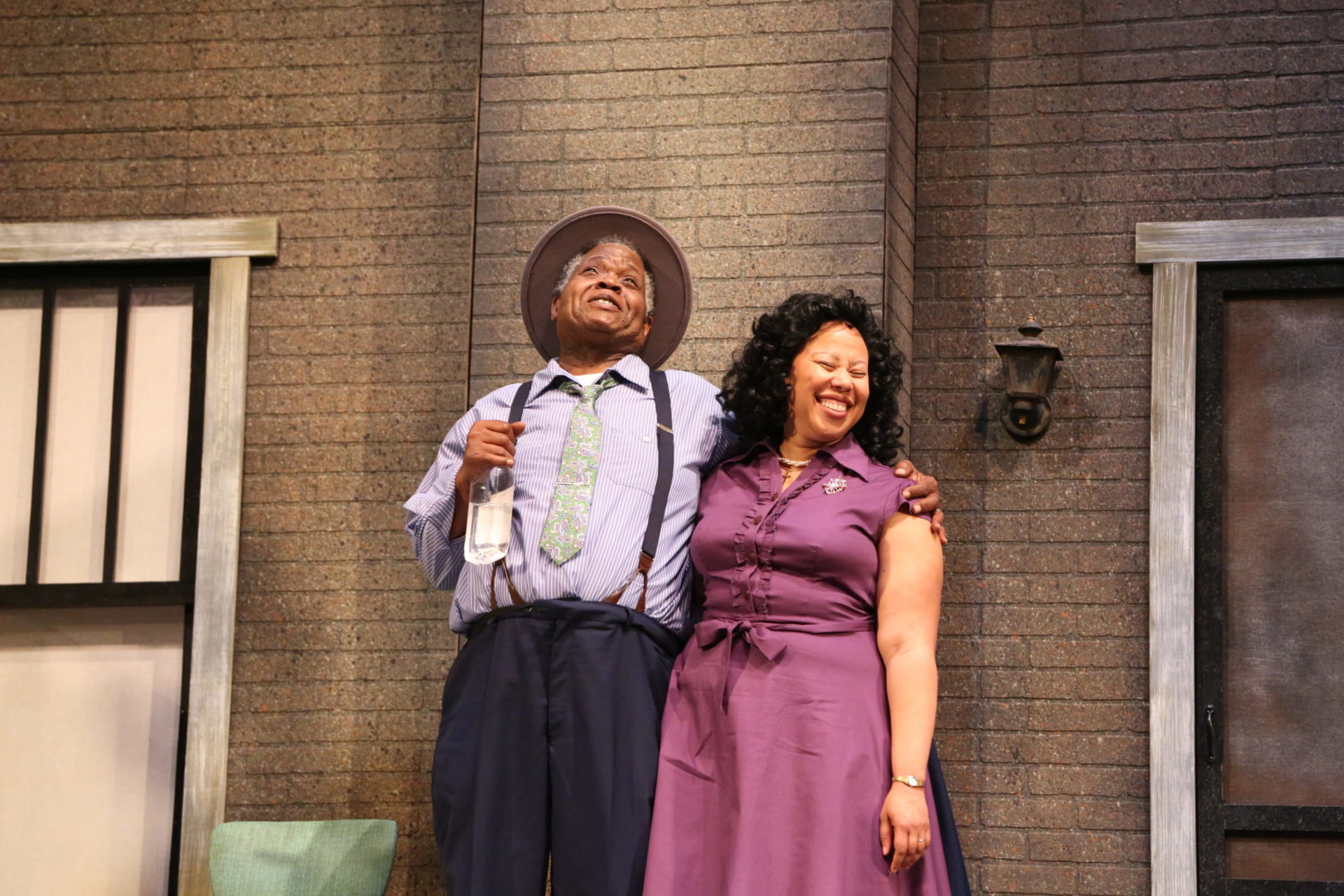
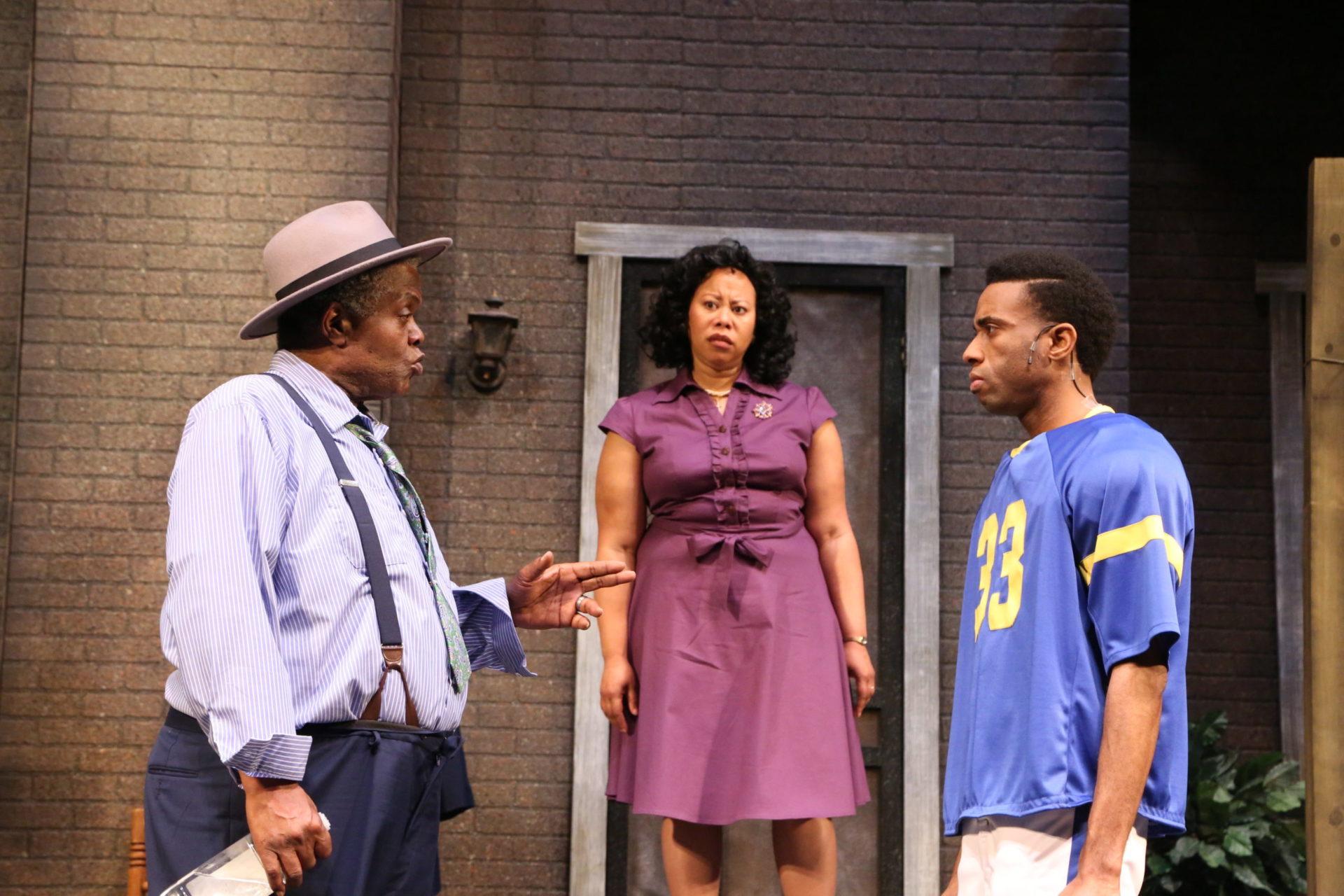
Fences deals with failure, change, aging, selfishness, forgiveness, racial discrimination, love, poverty, and pretty much everything else the human condition has to offer. It is excellent on every level. The dialogue is marvelous, the language, rhythm and tangents of the conversation are realistic. Each character is multidimensional and shown compassionately and often given a chance to explain their choices, the good and the bad. Some of them learn from their mistakes, others do not. The metaphors in this play –one being notably the fence that gives the play its name– are deep and multifaceted do not require ambiguity in order to fake profundity. The play is real, hilarious, empathetic, sad, and hopeful.
The play is set in the 1950’s. Troy Maxson is a garbageman who was a star baseball player in the Negro leagues before WWII. He’s married and has a teenage son. Frequent visitors to their yard are his co-worker friend, another son from an earlier relationship, and his brain-damaged war veteran brother. I won’t outline the plot because simply listing the events doesn’t give you the full story any more than a resume sums up your life. Troy is a father, a husband, and a friend. He is flawed and makes mistakes, big and small, and we see how these and his virtues combine with the flaws and virtues of others in his life, shaping their options and choices. For all his lectures to his son Cory about how he’s done his best for them as the provider, it turns out that their house was paid for by money that his brother received from the military after getting injured in combat. There is conflict between him and Cory, a football player with a college recruiter interested in him. Troy is still bitter about how racism prevented him from being able to play in the Major Leagues and tells Cory that there’s no point in playing sports; he should get a trade in something practical. Cory tells him that times are different now. It’s not just about football; this would be a path for him to go to college. Troy’s failure to see things differently, despite his wife Rose’s best efforts, was compelling.
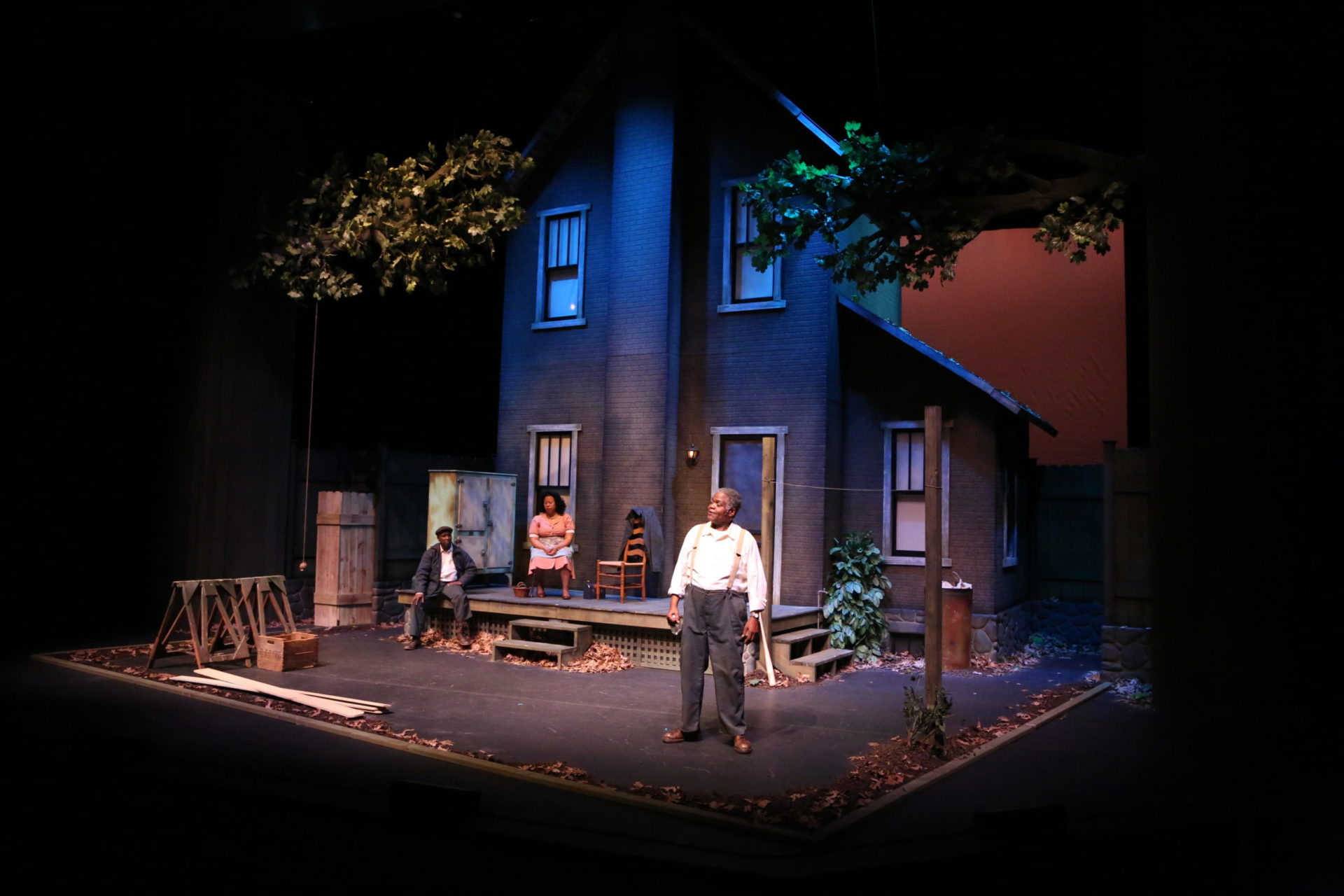
In the post-show Q&A the cast was asked how this play has stayed relevant. Clark Harris, who plays the lead role of Troy Maxson, said that it is still relevant because, even though this 80’s play is set in the 50’s, nothing is different; all the personal problems that characters in the play deal with are problems that people still deal with today.
Jon Royal directed a sincere, human performance. In the Q&A he spoke a little about trying to stay true to the text, which I think he did successfully; no parts ever felt forced, or as if aspects of the play were being pushed into more prominent places to fit some personal agenda. Instead it was clear that the text was respected and valued as much as it could be. In the program he wrote about when he was a child and unable to distinguish between a person living a happy life and one experiencing a happy moment. That ambiguity was alive in his production of this play.
Gary C. Hoff, the scenic designer, created a two-story house with a porch and a yard. It looked very real and after a few minutes I realized that expertly placed leaves were in all the exact places they get blown and remain if they aren’t raked away. That touch was what turned the set from being good to very very good.
I attended this play with my father, who has worked in media production for years, and he was impressed by André Allen’s ability as lighting designer, who managed to capture the look of streetlights shining through tree limbs. All the action took place in the yard, but a few times a character answered the phone inside the house or listened to the radio and their silhouette was projected onto the windows in a fun effect.
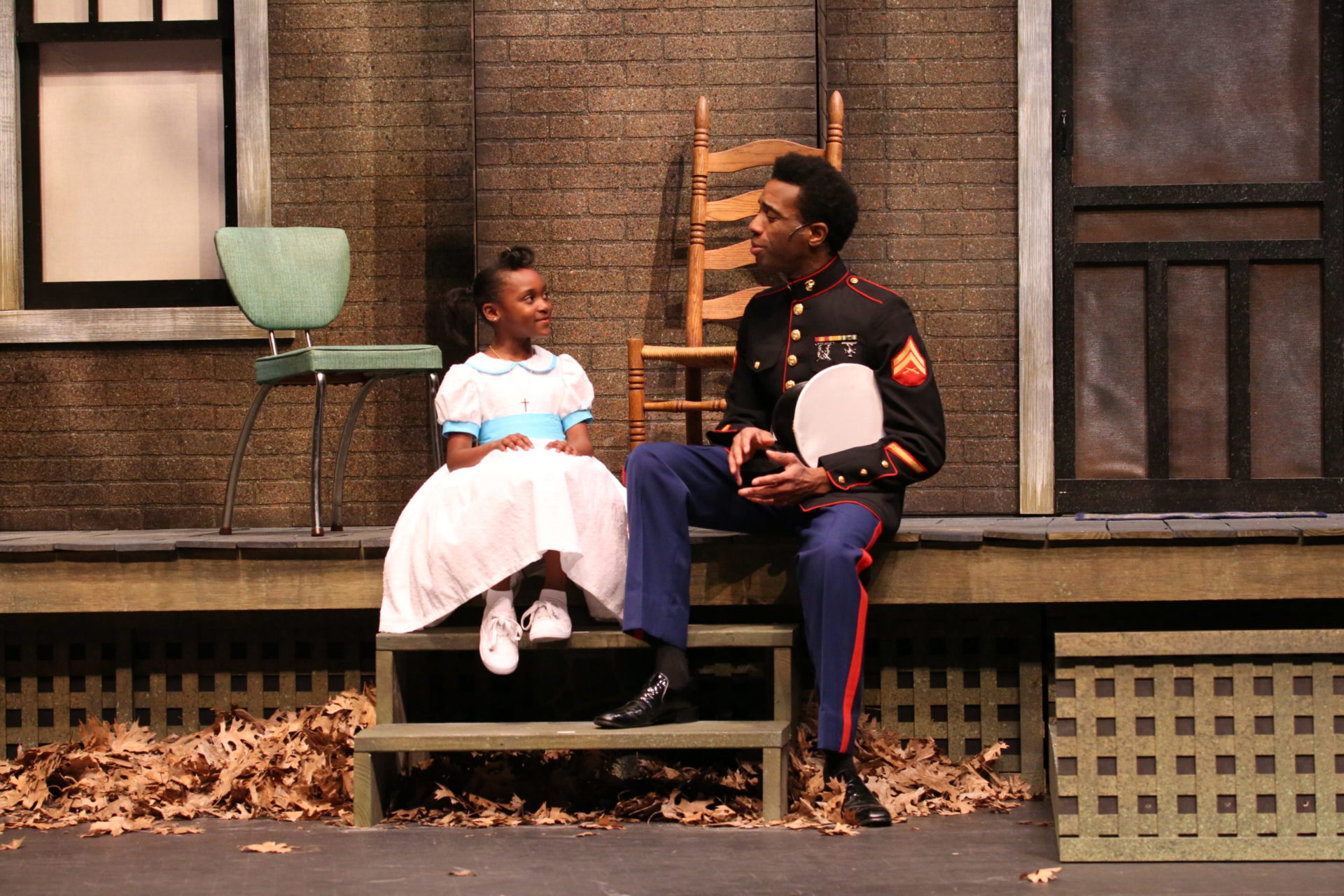
The cast was marvelous. Troy and Rose Maxson, played by Clark Harris and Alicia Haymer, worked together beautifully, their love and their tensions palpable. Clark Harris, playing an extraverted, dominating personality, had lines upon lines and monologues, but he never made them feel lengthy or recited. Playing a sometimes overly-dramatic character without coming across as hammy and unlikeable is difficult, and Harris achieved it. The rest of the cast’s dramatic and comedic timing was spot on, capturing the enthusiastic audience, which laughed and gasped at all the right moments.
Describing part of the Q&A will help show what watching the play was like. Jordan Marie Elizabeth Nixon played the child Raynell Maxson, and when asked about getting into character she said it was easy because she had two things in common with her role: “She is seven, and I’m seven too– for now,” she added meaningfully, with a knowing look at the audience that made everyone laugh. “And second, we’ve both lost somebody close to us.” The audience became unexpectedly serious. Laughter and pain are lifelong companions, and August Wilson and the Nashville Repertory Theatre gave a beautiful performance showcasing both.
Americans in the Schermerhorn
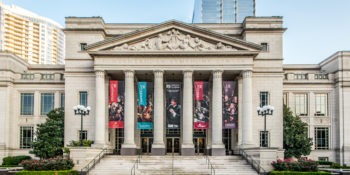
This past weekend was one of the most exciting programs that I had seen at the Nashville Symphony in a while. And for good

measure, this program encapsulated everything that the Nashville Symphony is all about: American music, new music, dazzling soloists, Grammy Awards, and of course, music-making on the highest level. The program started out with Pulse, a piece by Brian Raphael Nabors, an alumnus from the Nashville Symphony’s Composer Lab. After hearing this piece in 2019, conductor Giancarlo Guerrero decided that it deserved to be on a full subscription concert. Nabors has described the piece as “an episodic rhapsody that explores several phases and colorful variants of rhythm all held together by an unwavering pulse.” This twelve-minute piece certainty traveled through numerous chapters at such a rapid rate it felt that life was passing by too quickly. This piece is covered with imaginative orchestral effects, although I wish the audience was allowed a bit more time to wander in the soundscapes that Nabors masterfully created.
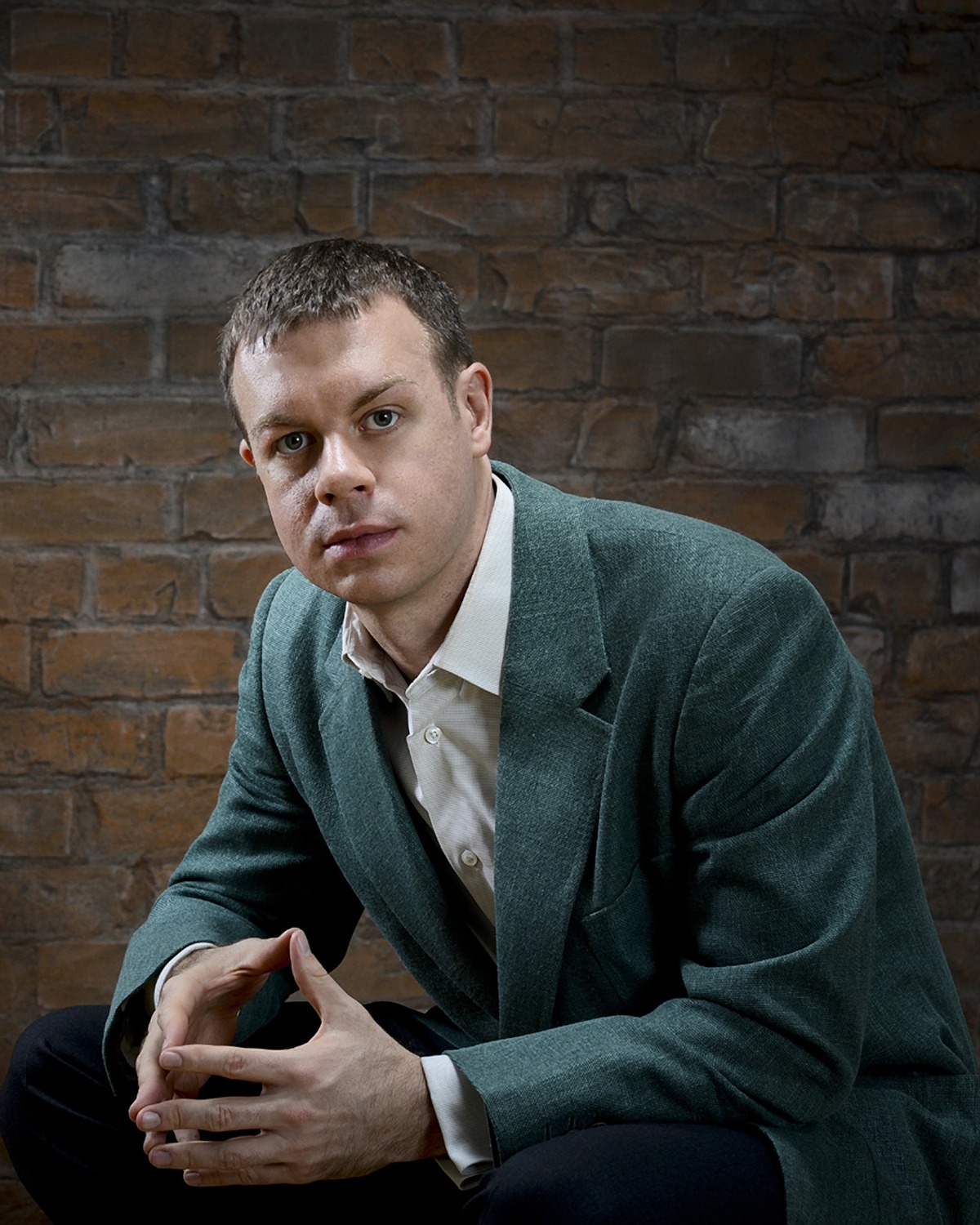
Second on the program was Resilience, by Wayne Oquin. Oquin is a faculty member at Julliard and has found success with his music in multiple genres, such as chamber works, wind band pieces, and full orchestral scores. Although Oquin’s name was familiar to me, I was not familiar with much of his work, so it was exciting to discover this piece by hearing it live. It is a 13-minute work with an organ solo played by Paul Jacobs. Before the piece there was an impromptu intermission while the stagehands roped off a section of stage and descended into the Schermerhorn’s depths to remerge a few minutes later with the organ. Resilience is a compact tour de force that explores the repetition of minimal musical materials in a struggle between the orchestra and the organ. This piece was formally much better structured than Pulse, but what struck me above all was the craftsmanship of the orchestration. The organ can be a tough instrument to write for because it is such an all-encompassing instrument by itself (Oquin in the program notes called it the “King of Instruments”). It has an expansive range and the numerous stops that can be pulled to change the timbre of the instrument. Typically this makes it hard to discern with the full orchestra. Despite this challenge, I was able to hear all of the organ’s notes with great clarity, something that I am not able to say for much of the organ pieces I have heard at the Schermerhorn.
When I was first seated at the beginning of the concert, I thought that I recognized Oquin as sitting right in front of me. I did not think I was correct until the few seconds right before Resilience started and he was sitting on the edge of his seat ready for the piece to begin. While the piece played, he unobtrusively conducted along, seeming to enjoy what he heard. It was wonderful to see a composer’s piece come alive right before the composers eyes. Oquin got a rousing ovation from the audience at the conclusion of his piece.
After a twenty-minute intermission the concert resumed with Christopher Rouse’s Organ Concerto. Written specifically for Paul
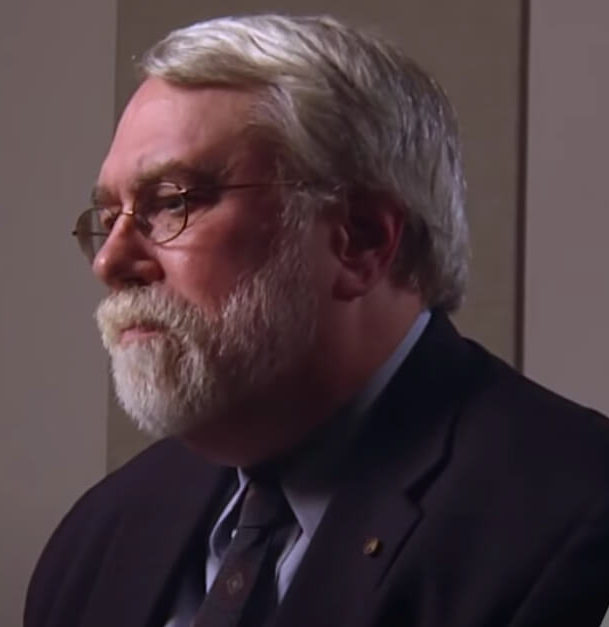
Jacobs in 2014, the Organ Concerto completes a CD of organ works that the Nashville Symphony has been in the process of making for quite some time. Rouse was no stranger to the concerto format, and this piece is a tightly packed version of a full-length concerto. Instead of the typical three movements, Rouse uses only three sections (fast, slow, fast). The outer sections are bursting with energy with a rhythmic drive that Rouse seems to have perfected. The slower middle section was a great contrast that highlighted the unique orchestration Rouse calls for; the only woodwinds required are bass clarinet and contrabassoon. In this section the lower ranges of each instrument are explored while the organ plays in the higher register – one way to navigate the aforementioned orchestration problem. This was a strong piece, although I definitely need to hear it again to get a better grasp on it. Hopefully this CD is produced very soon.
Paul Jacobs needs his own mention as he is easily one of the most sought-after organists alive today. He and the Nashville Symphony have partnered before on a Grammy winning CD. His playing in both Resilience and the Organ Concerto were nothing short of magnificent. He seemed at home at the Schermerhorn’s Organ as I am sure that he is at home at most organs. After the Rouse he had a hearty standing ovation that beckoned him out to the organ once more. He mounted it and over the shoulder only shouted one word to the audience: “Bach!” He then began a fantastic prelude (whose tune I recognized, but the name escapes me) that shows off the full virtuosity of the organ, feet and all. The audience erupted with applause and there was some serious desire for a further encore. Even the players, usually so stoic during a soloist’s encore, showed great pleasure in Jacob’s playing.
To bridge the gap of time it takes to lower the organ back to the basement, Maestro Guerrero came out and gave a brief speech about the history of the last piece on the program, George Gershwin’s An American in Paris. This was a great use of the time and Guerrero is a fantastic communicator in these types of speeches. He even gave a teaser for the upcoming Nashville Symphony season by saying that 2024 is the 100th anniversary of Rhapsody in Blue and the Nashville audiences would be hearing that piece “a lot”! The orchestra’s opening tempo was one of the brisker tempos that I have heard this piece performed. It worked in some sections, as it really did feel like the Parisian cars were barreling towards me and may knock me out at any moment, but in others I think a slower tempo would have helped the sensuality of the piece. Principal Trumpet William Leathers played the famous trumpet solos with extreme ease and just the right amount of schmaltz. Weirdly enough this piece was the low point of the night. Not due to any of the playing or mishaps, but the other pieces were just so interesting and fresh.
The programming was great on this concert with a discernable theme – American Music which fits squarely with the Nashville Symphony’s stated goals. All four pieces were roughly around the same length, which created an interesting and balanced evening. I am thankful that we were not stuck in the traditional and stale overture-concerto-symphony format (although there is plenty of that programming ahead on the calendar). The playing of the group was florid and crisp and Guerrero was right at home with this mixture of new, familiar, and old classics. Bravo everyone!
At TPAC's Polk Theater
August Wilson’s ‘Fences’ is coming to Nashville Repertory
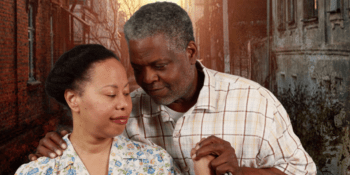
“August Wilson is truly one of the greatest American playwrights, and Fences is his masterpiece,” says Executive Director Drew Ogle. “After having to cancel our originally planned production due to the pandemic, we are so excited to finally be able to present this play, and we are even more excited to be partnering with the Tennessee Performing Arts Center to offer it to high school students in the region in addition to our usual audiences.”
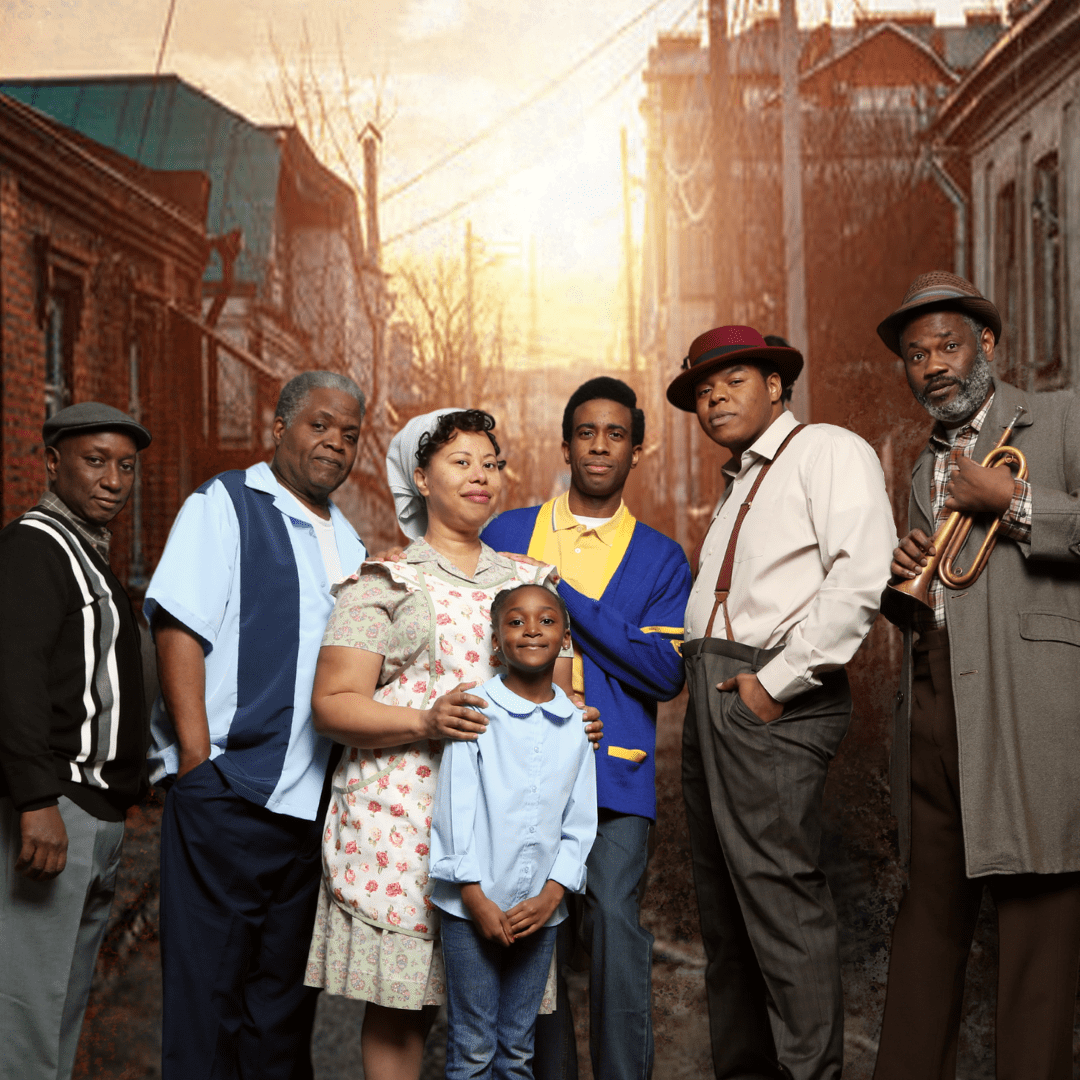
Fences is a Tony and Pulitzer Prize-winning play and explores the universal themes of love, loss, and the search for meaning in an unjust and unpredictable world. It is about the lives of a working-class black family in the 1950s, centering on Troy Maxson, a baseball star turned garbage collector who is haunted by his sense of failure and injustice in society. Through his relationships with his wife, his sons, his brother, and his best friend, Troy must confront the fences he has built around himself and his family and find a way to break down the barriers that stand between him and the life he desires.
Jon Royal, a Nashville Repertory favorite, returns to direct. “I want you to look at this play as an invitation for you to sit, and ‘linger’ with the Maxson clan until the lights come on,” says Royal. “Sit with them as they struggle to celebrate, commune, and walk the path of a family, trying to stay together. It’s no accident that this story begins with a Friday, after-work ritual. Laugh. Feel all of the feelings as we present to you the Maxon’s family ritual with Joy. “
The Nashville Repertory Theatre is performing August Wilson’s Fences Friday March 3 through Sunday March 5 at TPAC’s James K. Polk Theater, followed by school performances.
Tickets are available here. To find out more about the Nashville Repertory Theatre visit their website www.nashvillerep.org
At TPAC
The Nashville Ballet Publishes an Anthology of Nashville History
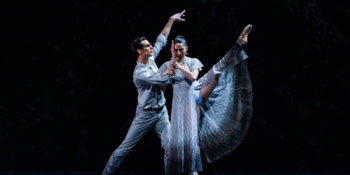
Before I returned home to Middle Tennessee, I binged ballet in New York and Houston, two American cities with world-class ballet companies. Having left decades ago when classical and modern dance were not even a twinkle in the toes of little would-be ballerinas in endless recitals, I must admit the binging represented a certain lack of faith that my dance options in Nashville would supply anything beyond the annual Nutcracker recurrence common in the most cities.
In New York, studying with a writer whose career began as a dancer, I had been engulfed in classical Japanese bugaku dance, classical western dance with the American Ballet Theater, historical western dance with the New York Baroque Dance Company, and a plethora of modern dance troupes, like Alvin Ailey Dance Theater, and of course, the quintessential Dance Theatre of Harlem and New York City Ballet. I had come back once for a short-term residency at Belmont University when they opened their dance program years ago.
So my expectations in Nashville took on a “wait and see” posture. And when my first Music City Review dance assignment—an exciting Nashville Ballet program of new choreographies set to two of my absolute favorite pieces of ballet music, Aaron Copland’s Billy the Kid and Igor Stravinsky’s The Firebird—ended in failure due to an untimely outbreak of Covid in the orchestra, I had a moment of fellow feeling with Tennyson’s Lady of Shalott when she cried out, “the curse is come upon me.” I had been curious about the courage, or chutzpah, NB director Paul Vasterling must have to approach choreographers highest in the pantheon of modern dance, like NYCB’s George Balanchine and Eugene Loring, whose Billy the Kid is often placed alongside Agnes de Mille’s choreography of Copland’s Rodeo.
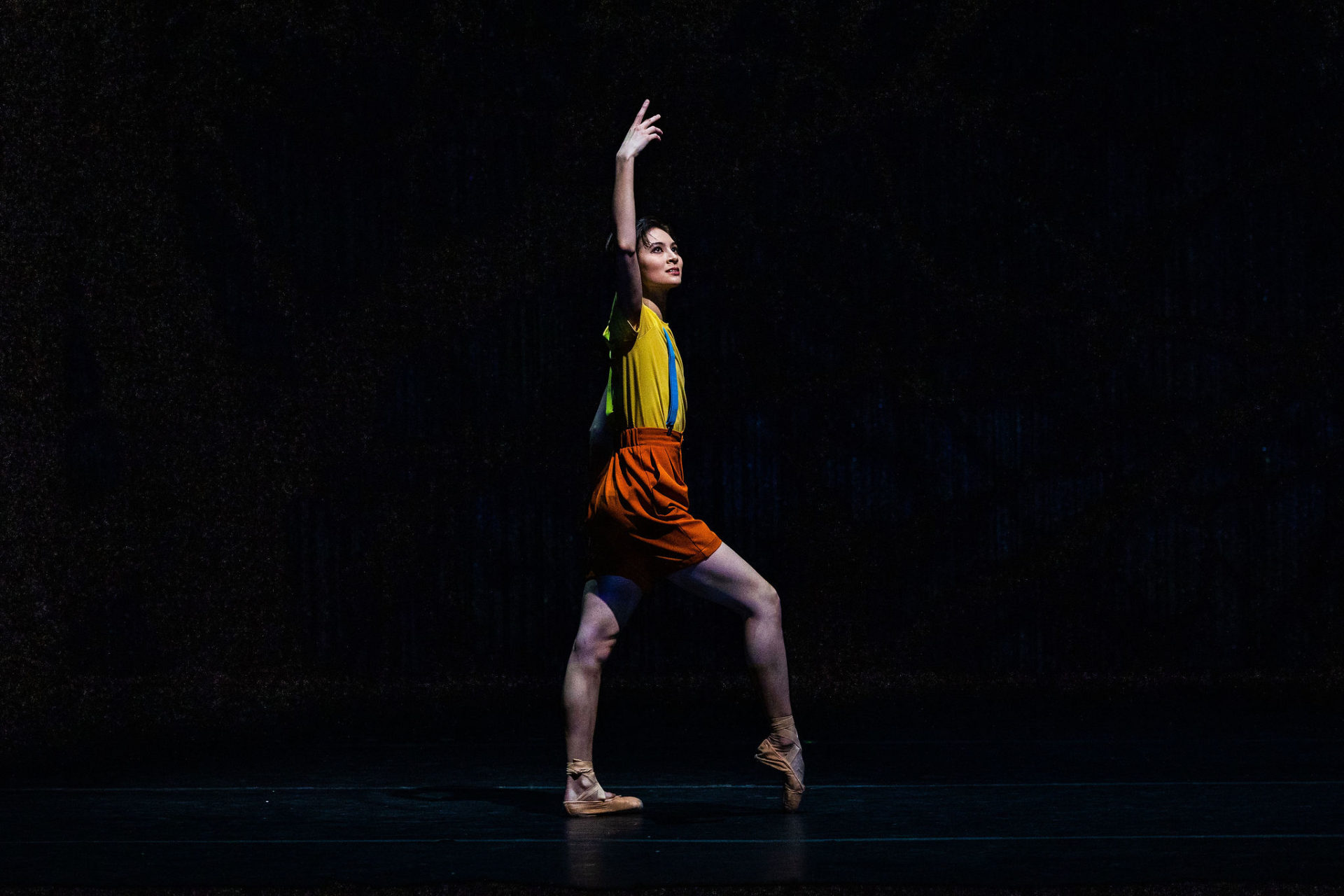
Things picked up when I reviewed Malpaso, the fascinating and highly skilled modern dance troupe from Cuba, hosted by OZ Arts, but still, that wasn’t homegrown product. Anthology finally introduced me to how much Nashville’s dance has flourished while I have been away. It did not disappoint.
Set in the Nashville City Cemetery, Anthology is a series of stories ranging from laborers to law enforcement, puppies to painters, archeology to art. One of the most intriguing aspects was something unexpected. I had anticipated competent dancing and, in the Music City, well-performed music, but the imaginative amalgamation of a piano quintet (2 violins, viola, cello, piano) playing haunting modern music, a deeply romantic Beethoven piano trio, a country music singer, a gospel trio with jazz skills, and dance that smoothly leaped from classical European to modern American to traditional African styles caught, and kept, my attention.
Muted stage lighting in the opening scene revealed hanging slats suggesting aerial tombstones. The entire first half of seven vignettes was choreographed by Vasterling, with one exception. Jordan Lehning’s opening music, akin to the mysticism found in the music of famed Estonian composer, Arvo Pärt, draped the audience perfectly in the lush yet melancholy ambiance of the Nashville City Cemetery. Much of the costuming matched the initial gray mood and sets while the “Living One” is appropriately dressed in bright primary colors.
As the Living One, Sarah Pierce served well as a jaunty choreographic narrator, a throughline gently threading the stories of Anthology together. Her movements, dressed in a child’s shirt, shorts, suspenders, and a yellow cap represented the joys of living, particularly the gesture of hopping on one foot in hopscotch fashion, then ending maturely en pointe. Her intermittent presence unified tales ranging from prehistoric times to the 1960s
Highlights of the second scene included shadowy figures behind a misty curtain, figures slowly strolling onto the stage, dropping to the floor and, in the 1200 AD vignette, writhing on the floor like earthworms buried underground near the graves. Another effective moment was the lovely fusion of Beethoven’s “Ghost” trio in the 1960s section with variegated clusters of ghostly dancers all clad in variegated shades of gray: pas de deux, pas de trois of two men, a man and a woman, two men and a woman. This section is meant to tell the story of a philanthropist, the woman he chose to marry, and his true love, another man.
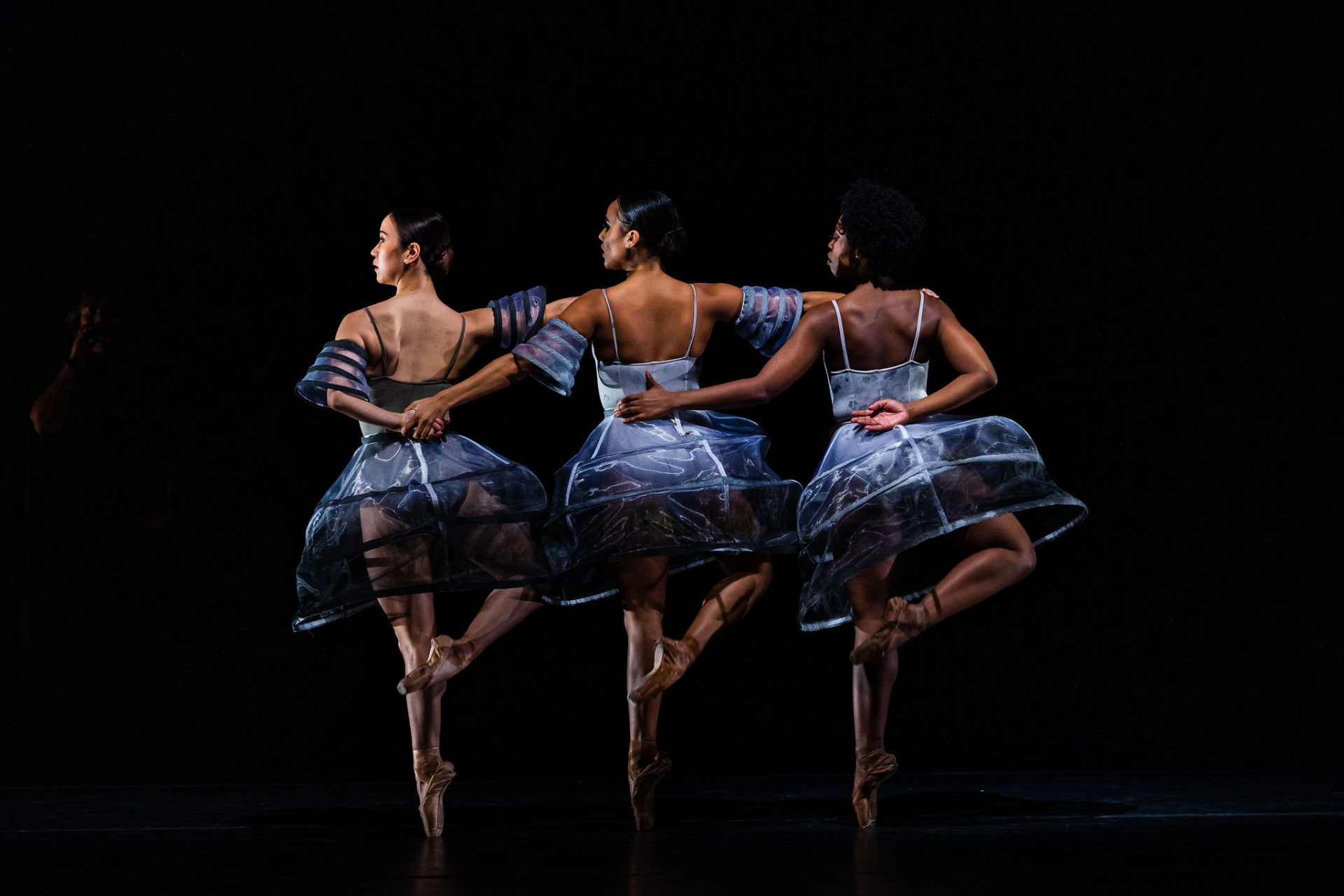
Sidra Bell’s BA in History and MFA in Choreography made the 1880s a perfect segment for her tale of Lucinda Bedford, an African American woman who was one of Nashville’s wealthiest residents. The elegance of this section was well-complemented by the bright 1929 “Buddy” section, a tribute to loyal pets. After a twenty-minute intermission, Vasterling’s work shared the stage with individual vignettes by Shabaz Ujima, Aeron Buchanan, Mollie Sansone, and Windship Boyd.
Although it was premiered during Black History Month and did include both stories of, and choreographies by, African Americans, one bit of disappointment was the lack of music by black composers or even epigraphs from black writings. Yes, black dancers were featured and yes, music with black sensibilities was represented, but music is so vital to dance, its absence was notable.
Another issue, trickier to address, is the difference between the quality of material and the quality of performance. Sometimes in concerts, a disjunct occurs between these two vital elements. For example, a poor performance can undermine the reception of a fine new work.
On the other hand, a stellar performance can make a weak work seem better than it is. Country musician Morgan Karr, also known as MORGXN, sat on a stool stage left dressed in a black suit with red floral sparkles that gave just the right tribute to country music’s rhinestone cowboys of bygone days. And his lovely voice, much like Dolly Parton or Alison Krauss, or other Nashville cats with voices “clean as country water,” was a fresh addition to the programming, but lyrics with redundant ideas like “you’re the only one I’m dreaming of” and “hold me till the world falls apart” drained some of the purity from that water.
Similarly, asking a relatively new composer like Lehning to compete with a master like Beethoven takes more than I witnessed. Lehning’s compositions began effectively, but after a while, the choreographic creativity outstripped that of the music. This disconnect loomed largest in the 1870s segment on Ella Sheppard Moore, a founding member of the Fisk Jubilee Singers. Claudia Monja danced with polished grace, but the music seemed a bit out of place for honoring spirituals.
Windship Boyd, guest artist who is also cofounder of AfricaNashville, an organization dedicated to connecting American and African cultures, opened Act II, Scene 3 with one of the most charming vignettes of the evening, celebrating Albertine Maxwell, founder of the Nashville Ballet Society. The transition from lockstep classical Barbies coming to life as they follow one wild spirit, freeing themselves from their toe shoes, finding the full flexible glories of their dancing bodies, worked beautifully to lighten an otherwise somber mood.
Metaphorically, the Maxwell account rhymed with Shabaz Ujima’s African-influenced “Speak Their Names” in Scene 1. Ujima frames his narrative around a conjure woman leading members of a formerly enslaved family celebrating their reunion in the afterlife. Both Ujima and featured artist, young Cyrus Pittman, a student from the School of Nashville Ballet, put to rest one of my main concerns. With all the other featured artists born and trained elsewhere, I couldn’t help but wonder if Nashville Ballet is growing its own crop of dancers to seed its future. But both Ujima and Pittman are Nashville trained. Ujima left and returned, having enriched his obvious gifts through travel. This was one of the most well-received sections of the program.
Despite the eclectic mix of disparate dance styles, musical genres, and choreographers, Vasterling preserves an underlying unity, a unity that is part of the ideal American dynamic. In its inclusion of these living artists and these stories of Nashville’s vibrant past, Anthology is a fitting testimonial to the director’s creativity and the future of dance in Nashville.
Winter Shakespeare Presents:
Love’s Labor’s Lost: An Approachable, Silly Night
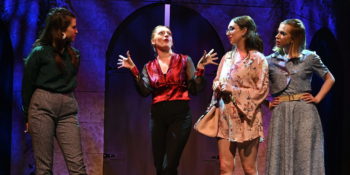
Most of us have read or seen Shakespeare’s big tragedies and comedies, Hamlet, Romeo and Juliet, A Midsummer Night’s Dream, The Tempest and so on. I was unfamiliar with Love’s Labor’s Lost, one of his early comedies, before watching the Nashville Shakespeare Festival and Belmont University’s Department of Theatre and Dance perform it opening night, February 16th. This play was slightly abridged, the director Denise Hicks credited as Editor. After the performance I looked through my library copy of the play and googled it. It seems that she has done a good job of cutting out parts that aren’t comprehensible to non-Shakespearean scholars; one of the reasons this play isn’t performed as frequently as others is that its unabridged form is full of banter based on esoteric references.
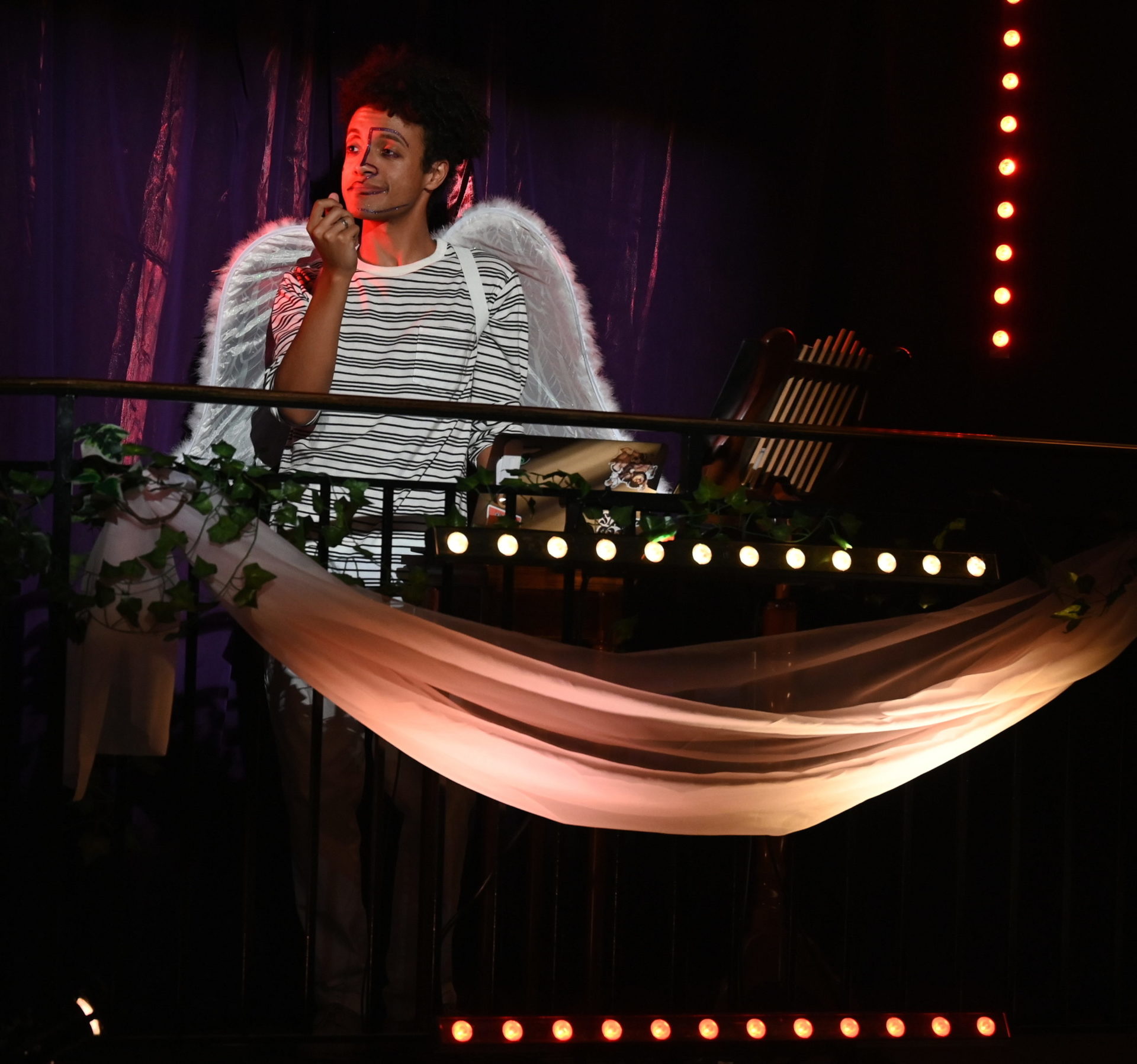
Love’s Labor’s Lost is simple and silly; I went in expecting a convoluted plot, identical twins and warring states with disguised characters sowing confusion. Instead it is rather simple, the great misunderstanding being between people wooing sincerely and people flirting for fun. There are almost no subplots and all the matters of state are almost ignored. Basically, the play follows a king and his lords who make a vow to be perfect scholars and avoid women and other distractions for three years. As soon as they finish making the vow they are notified that the Princess of France and her ladies in waiting have arrived to discuss an important political matter. The men fall instantly in love and the women think they are just goofy charmers. Everything is flirtation and pranks and minor misunderstandings leading up to a happy ending. And all this happens in about two hours with a ten minute intermission, requiring less endurance than your typical Marvel movie.
The freshness of this unfamiliar play and the almost entirely Belmont student cast pairs well; the enthusiastic vows and infatuation and stunts and immaturity would not be as enjoyable or hopeful if they were performed by an older cast. This young cast is solid: audible and able to fluidly speak their lines as well as able to act with comedic timing. The beginning of the play opening night had no long faculty speeches thanking people; the lights went down, the typical recording requested that people silence their cell phones, and the performance began. Sound, lighting, stage resets, and the like went smoothly and professionally.
The stage design is simple: an exterior scene with a few props and an indoor scene decorated like a dorm room. Matching the college feel is the abundant use of music, from Erik Satie to Baha Men. Some of the musical moments have a rather TikTok vibe but it almost always is successful, continuing the modern feel of the performance. The sound design is by Jonah Burch, who also features as Cupid. An addition to the play, Cupid’s spotlighted DJ presence throughout the entirety of the show is occasionally distracting but often funny.
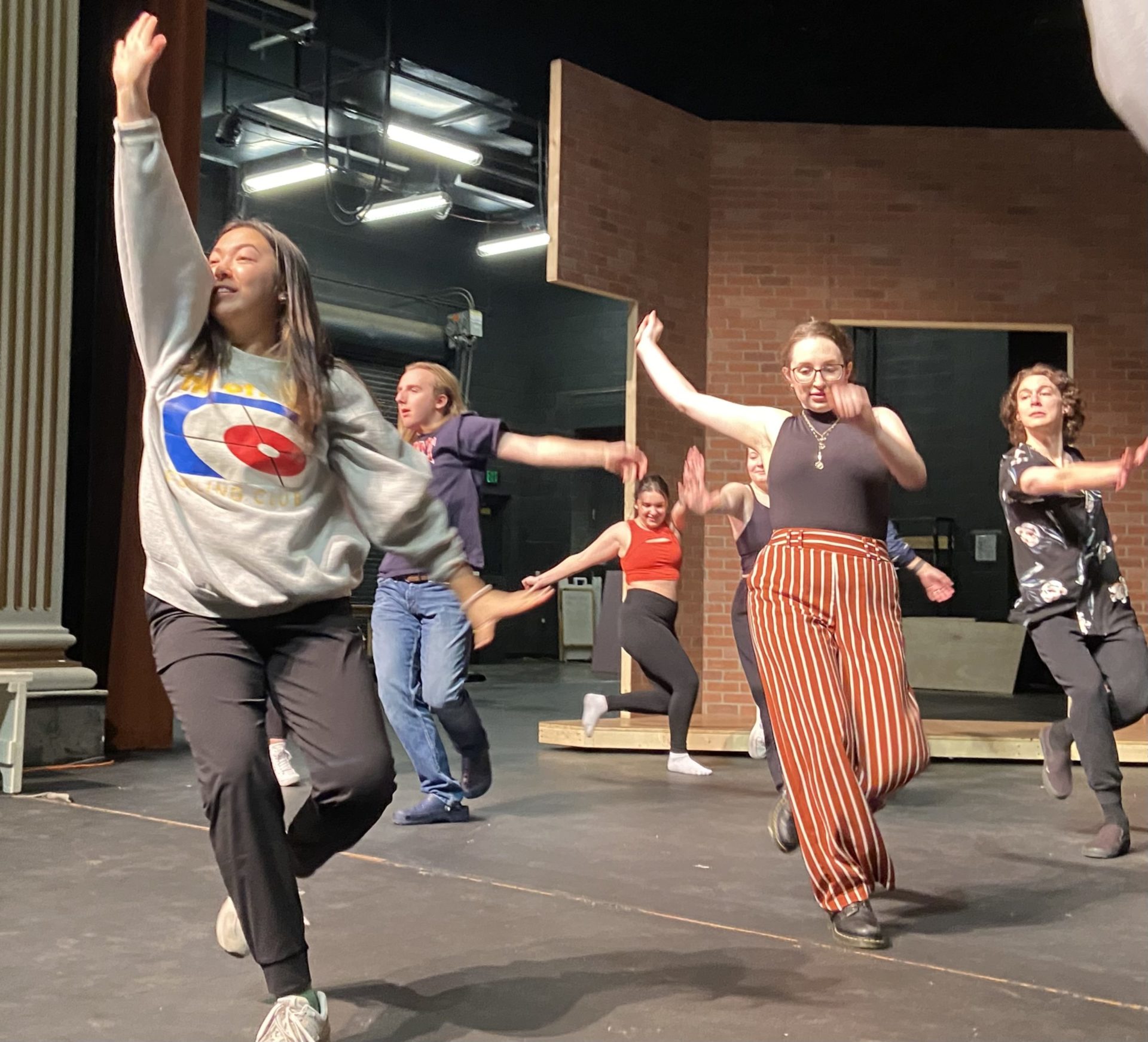
The costumes were mostly modern; the women in dresses, slacks, and rompers, the men mostly wearing button downs with the occasional vest, making the men seem more old-fashioned. The lovers are paired in matching colors which is a nice and helpful touch. The Princess of France’s dress and jacket are lovely and did a good job of setting her apart.
Accompanying the music is Calista Morrison’s choreography. The in-scene dances were energetic and funny, but the best moment is an added scene, where three deer and the princess perform a sort of hunting ballet. The audience, who laughed a lot and was engaged throughout the entire play, laughed the loudest here, as did I. The final scene in the play ends with a full-cast dance and, somehow, it works. The cast also dances to themed music through their bows and it makes for the smoothest ending applause I’ve seen.
The location is excellent; parking at Belmont’s South Garage is free and easy, just around the corner from the venue, and many tasty off-campus restaurants are a few minutes’ walk away, making it perfect for dinner and a show. We had ramen, Chick-fil-a milkshakes, and a nice walk around scenic campus before the play. The Troutt theatre is lovely and the seating is actually comfortable with a good view of the stage. Although it’s not an inexpensive date at almost $30 a ticket (student tickets are around $21), it is more fun than a movie and avoids the outdoor inconveniences of Shakespeare in the park.
This is the perfect play both for someone who is familiar with Shakespeare and wants to see something less-well known, and for someone who isn’t terribly familiar and wants an accessible, fun play. It is approachable (students sat behind us discussing the merits of Disney Channel Original sequels before the show and were engrossed by the play) and I’d highly recommend it to all, especially those looking for a fun date during the dreariest month of the year.
Love’s Labor’s Lost has shows February 18 and 19, and the 23rd through the 26th.
Here’s a link to performances and tickets: https://www.nashvilleshakes.org/winter-shakespeare
From the Nashville Symphony
A Latin Fiesta at the Schermerhorn
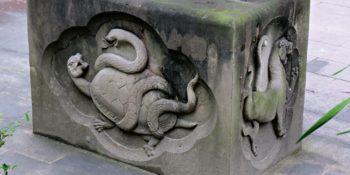
A Latin Fiesta at the Schermerhorn
On February 3 & 4 the Nashville Symphony gave a rather eclectic and unconventionally exquisite concert billed as a “Latin Fiesta!” with a group of interesting works including Chen Yi’s Introduction, Andante and Allegro, Arturo Márquez’s Fandango featuring the great Anne Akiko Meyers on Violin, with both framed by Maurice Ravel’s works: Alborada del gracioso and his Rapsodie espagnole.
Ravel’s Alborada del gacioso (roughly translated as “the morning clown’s song), written in 1905, began its existence as one of five short piano pieces Ravel wrote to be included in his suite Miroirs (Mirrors). In 1909 the famous impresario of the Ballets Russes, Sergei Diaghilev, visited Spain and as a result, commissioned a number of ballets on Spanish themes. Leonid Massine took one of the commissions on and choreographed a work that included Ravel’s piano version. In response, Diaghilev then commissioned Ravel to orchestrate the piece for the ballet’s premiere (titled Les jardins d’Aranjuez).
As such, it is a brief, colorful work for orchestra in three main sections, a central clown’s song framed by lively dance music. The Spanish ambiance is obtained through pizzicato strings imitating guitars and the use of castanets, tambourine cymbals and harp, performed wonderfully by Nashville’s percussionists. It is a beautiful piece that might just feel a bit brief, but then the orchestra began to make way for the soloist, Anne Akiko Meyers.
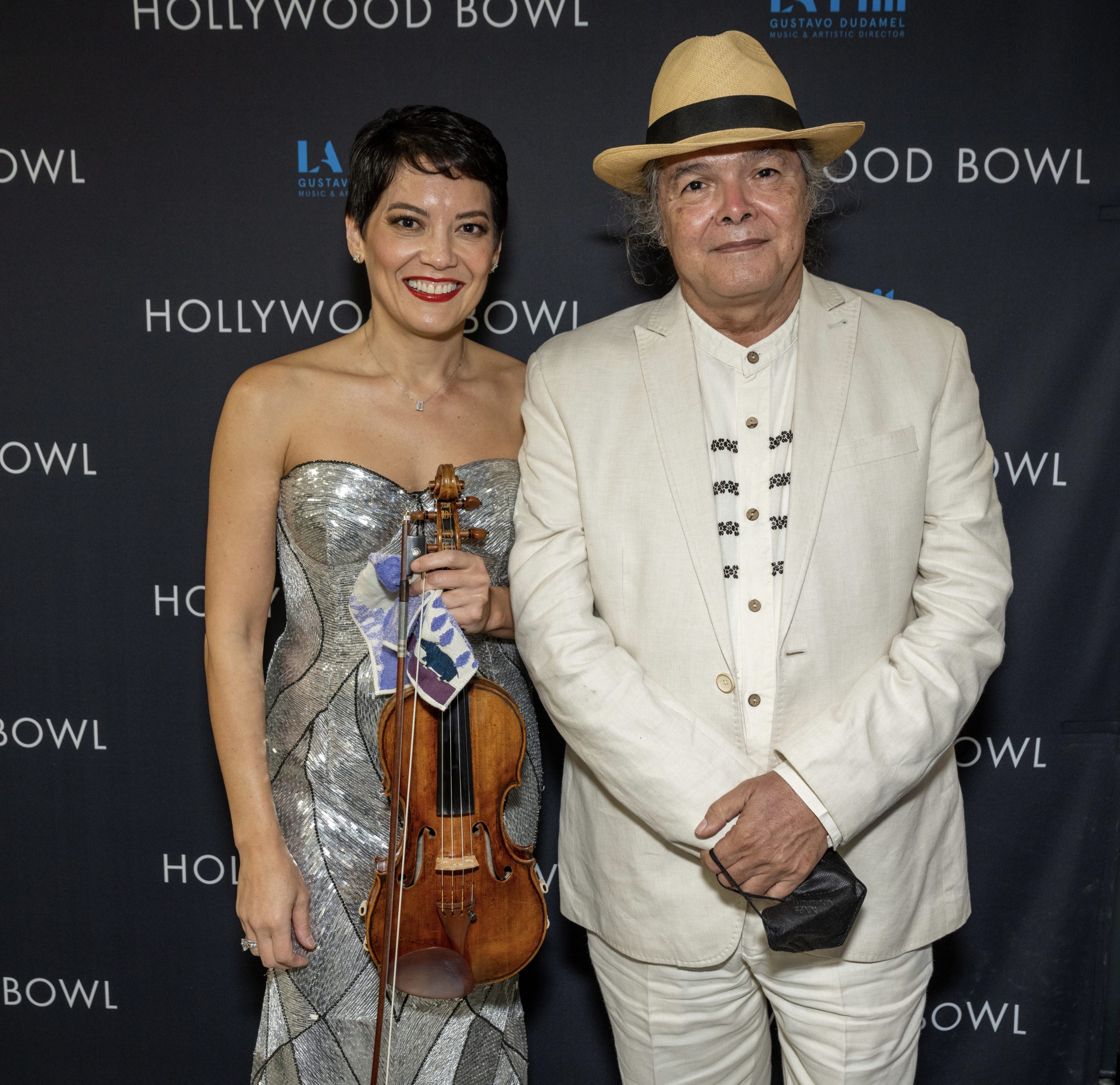
In 2018 Anne Akiko Meyers, international celebrity violinist, approached the great Mexican composer Arturo Márquez and “…asked if he would be interested in writing a violin concerto incorporating Mariachi traditions.” Márquez then completed a work, titled Fandango, that he had been considering for over a quarter of a century, and Meyers has been championing the work ever since. The Fandango has long been understood to be a Spanish genre due to its emergence there sometime in the 18th century. In Mexico, the term also signifies a party where people get together to dance, to play, and to sing in a community setting. It is to this tradition that Márquez is referring in his title. The piece is in three movements (fairly standard for a concerto) but with characteristic titles: Folia Tropical, Plegaria (Chaconne) and Fandanguito.
The Folia Tropical, in a standard 1st movement allegro form, opens with an intense cadenza leading to a dance which the orchestra eventually takes up. After a brief transition, a soaring melodic line over an ostinato gave Meyers a moment to show the versatility of her abilities—you could tell the piece was written for her and the intensity and spirit in which she approached the performance was breathtaking. At the end of the movement the room was moved to applause despite the fact that we (should) know better—it was marvelous. The room chuckled when Meyers’ smiled and assured us “There’s a lot more music to come.” And indeed there was. By the end of the evening Meyers had won over the audience with this remarkable composition; One waits earnestly for the recording.
After intermission, Maestro Guerrero came on stage and took a moment to introduce Chen Yi’s Introduction, Andante and Allegro from the podium. There he described the two sacred animals from Chinese legend that inspired Chen’s work: Xuanwu, the representative of the north and winter, often depicted as a turtle entwined with a snake; and the white tiger, the symbol of the west and autumn. The work, inspired by Chinese Opera (described by Guerrero as “over the top”) is exciting and dynamic. The first movement draws on a pentatonic construction based on a Chinese folk tune. Chen Yi was one of those children who were sent to the countryside during the cultural revolution to be “rededucated.” This personal catastrophe at least allowed for a generation of China’s most talented musicians, in the middle of their training, to interact with the culture’s folk genres, adapting and reincorporating them into their emerging, Western-inspired voices.
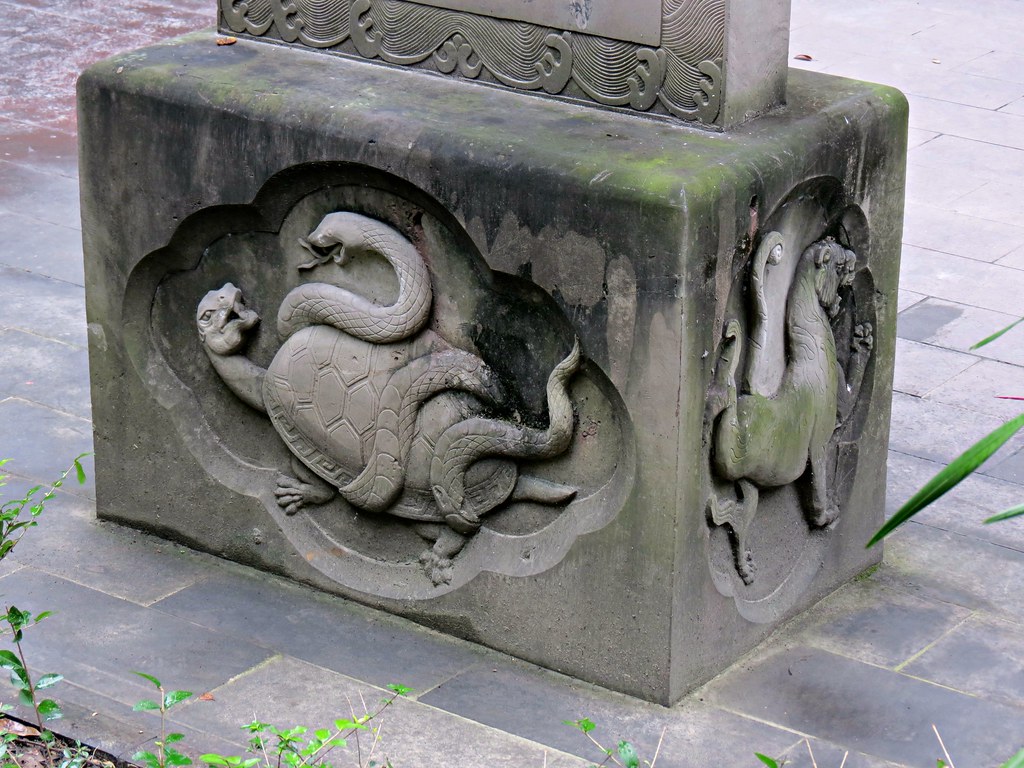
The central movement with its “dark and mysterious” soundscape is marked by quartertone harmonic language within a wide open, but somewhat threatening vistas; it is much more snake than turtle. The Allegro’s tiger ostinato, ever prancing through the forest, was troubling and delightful. The micro-tonality of the piece was mesmerizing, especially the way in which the sounds were introduced in a gentle, accessible way, it was Chen’s skill as an orchestrator that were most remarkable for me—the way she creates an inner work with the ensemble (and the way our symphony performed it) was in many moments positively Mahlerian.
The evening ended with Ravel’s Rhapsodie Espagnole, another early piece that he wrote for piano before fully orchestrating it, now under the light of Chen Yi and Márquez, Ravel’s turn of the century Spanish innovations seemed almost conventional, indeed it was remarkable that Guerrero and company managed to create a concert so progressive that Ravel became the chestnut! In looking around at the standing ovation, I wondered that their were empty seats–could the “music city” be so wary of something so beautiful because it was new? It seems that the Nashville Symphony has more work to do. The Nashville Symphony returns on February 23-25 featuring Paul Jacobs on organ, with “An American in Paris” in which Gershwin’s masterpiece will be paired with another set of brand new works, some of them being recorded (Grammy anyone?). Make a showing people, you’ll want to say you were there when this happened!

